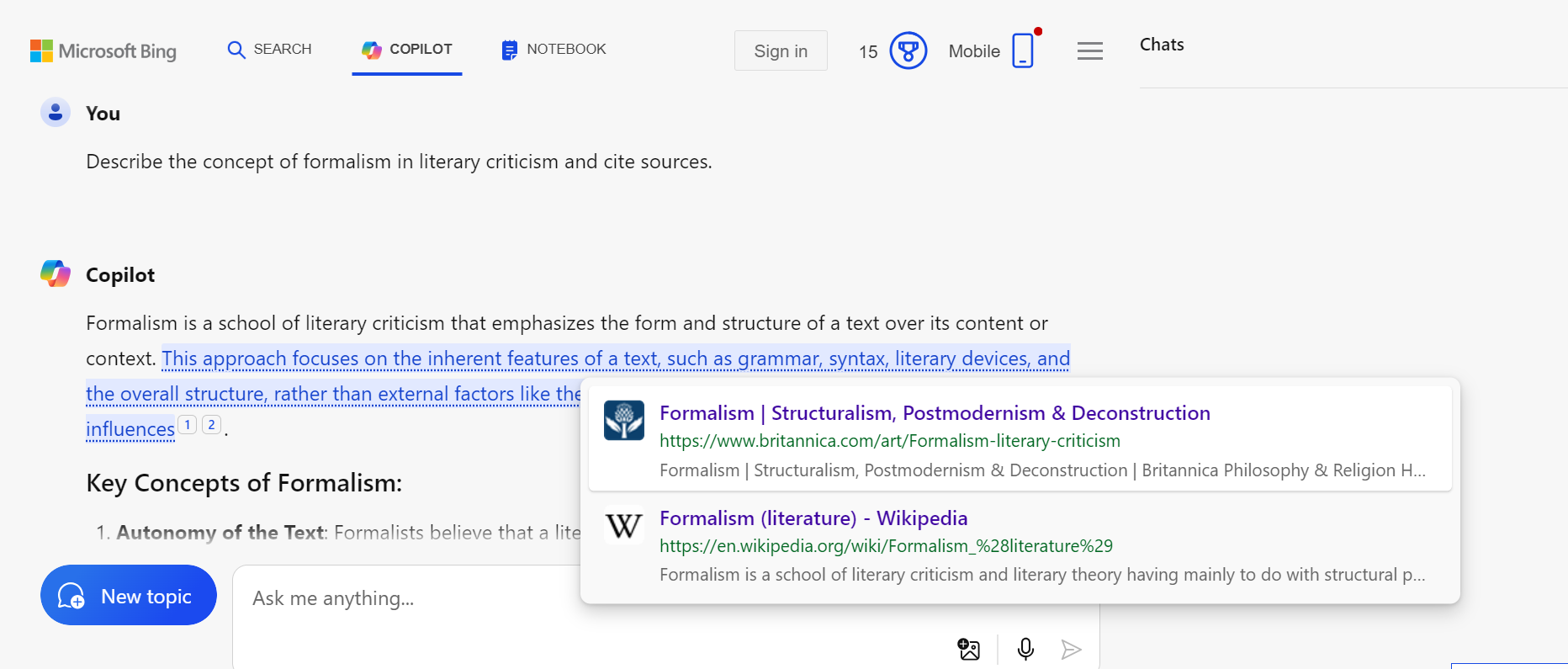In March 2023, we published a post about how to cite generative AI, such as ChatGPT. While our guidance has largely remained the same, given the rapidly evolving nature of AI tools, we decided to update our guidance and provide new examples using the current AI models from OpenAI and Microsoft.
In “Using the MLA Template” below, we have updated how to use the MLA template of core elements to cite generative AI. One of two significant changes we’ve made is clarifying that providing a stable, shareable URL to the AI conversation you are citing is preferred, but a general link to the AI tool can be provided if that stable URL feature isn’t available in the tool you are using. The other significant change is that we recommend that the AI tool’s model name or number be included in the Version element. So, for example, the works-cited-list examples in this post cite the GPT-4o model of ChatGPT.
We’re also providing new example citations below. The examples reflect newer ChatGPT, DALL-E, and Copilot models, and we’ve also provided additional guidance to clarify citing secondary sources used by AI.
To acknowledge more substantive uses of AI in your work that go beyond citation, see our post on acknowledging AI and the limits of citation.
Using the MLA Template
Author
We do not recommend treating the AI tool as an author. This recommendation follows the policies developed by various publishers, including Cambridge University Press, the partner publisher of the MLA’s journal PMLA.
Title of Source
Describe what was generated by the AI tool. This may involve including information about the prompt in the Title of Source element if you have not done so in the text.
Title of Container
Use the Title of Container element to name the AI tool (e.g., ChatGPT).
Version
Name the specific AI model or model version as specifically as possible. For instance, the examples in this post were developed using the GPT-4o model of ChatGPT.
Publisher
Name the company that made the tool.
Date
Give the date the content was generated.
Location
Give the stable, shareable URL for accessing the generated content (e.g., text, an image, etc.). For example, tools like OpenAI’s ChatGPT and DALL-E allow you to share a link by clicking the Share link at the top of the chat conversation. If the tool you are using doesn’t provide a stable, shareable URL, provide the general URL for the tool.
Example 1: Paraphrasing Text
Passage in Source
“Nature in Mansfield Park often mirrors the personalities or inner states of the characters. The different environments – Mansfield Park, Sotherton, and the wilderness at the parsonage – are symbolic of the moral choices and the values of the people who inhabit them.”
Paraphrased in Your Prose
In Mansfield Park, physical locations like Mansfield Park and Sotherton reflect the morality and choices of the people who live in them (“Describe the theme”).
Works-Cited-List Entry
“Describe the theme of nature in Jane Austen’s Mansfield Park” prompt. ChatGPT, model GPT-4o, OpenAI, 23 Sept. 2024, chatgpt.com/share/66f1b0a0-d704-8000-be9a-85f53c850607.
Example 2: Quoting Text
Passage in Source
“Nature in Mansfield Park often mirrors the personalities or inner states of the characters. The different environments – Mansfield Park, Sotherton, and the wilderness at the parsonage – are symbolic of the moral choices and the values of the people who inhabit them.”
Quoted in Your Prose
Nature is depicted frequently throughout Mansfield Park, and it “often mirrors the personalities or inner states of the characters” (“Describe the theme”).
Works-Cited-List Entry
“Describe the theme of nature in Jane Austen’s Mansfield Park” prompt. ChatGPT, model GPT-4o, OpenAI, 23 Sept. 2024, chatgpt.com/share/66f1b0a0-d704-8000-be9a-85f53c850607.
While we’ve provided fairly detailed descriptions of the prompts above, a more general one (e.g., Theme of nature in Austen’s Mansfield Park prompt) could be used, since you are describing something that mimics a conversation, which could have various prompts along the way.
Example 3: Citing Creative Visual Works
If you are incorporating an AI-generated image in your work, you will likely need to create a caption for it following the guidelines in section 1.7 of the MLA Handbook. Use a description of the prompt, followed by the AI tool, model name or version, and date created:

Fig. 1. “Create an expressionist-style image of two people standing on a beach looking at the ocean” prompt, DALL-E, version 3, OpenAI, 23 Sept. 2024, chatgpt.com/share/66f1c3a3-3f90-8000-9750-82c57c4a6592.
You can use this same information if you choose to create a works-cited-list entry instead of including the full citation in the caption (see MLA Handbook, sec. 1.7).
Example 4: Quoting Creative Textual Works
If you ask a generative AI tool to create a work, like a poem, how you cite it will depend on whether you assign a title to it. Let’s say, for example, you ask ChatGPT to write a free verse poem titled “The Oak Tree” that—you guessed it!—describes an oak tree and then quote it in your text. Your works-cited-list entry might look like this:
“The Oak Tree” free verse poem. ChatGPT, model GPT-4o, OpenAI, 23 Sept. 2024, chatgpt.com/share/66f1c740-7500-8000-a38b-6d6045c811f5.
If you did not title the work, incorporate part of or all of the first line into the description of the work in the Title of Source element:
“The autumn leaves fall softly to the ground . . .” sonnet about autumn. ChatGPT, model GPT-4o, OpenAI, 23 Sept. 2024, chatgpt.com/share/66f1ce9d-0b38-8000-a209-112496d3e0b1.
For guidance on using descriptions and text from the work itself in the Title of Source element, see the MLA Handbook, 5.28 and 5.29.
Example 5: Citing Secondary Sources Used by an AI Tool
In our previous post, we recommended the following regarding citing secondary sources found by an AI tool: “You should also take care to vet the secondary sources cited by a generative AI tool—with the caveat that AI tools do not always cite sources or, when they do, do not always indicate precisely what a given source has contributed. If you cite an AI summary that includes sources and do not go on to consult those sources yourself, we recommend that you acknowledge secondary sources in your work.”
That guidance is still accurate, but the example we provided in that previous post was from Bing AI, which has now been rebranded as Microsoft’s Copilot tool, and it has a different interface, as you can see in the screenshot below.

If you wanted to cite information from that second sentence that is highlighted, you should click through to the cited sources and use those directly as the source that you cite. So, in the example above, you would click through to the web page on the Britannica site that describes formalism.
We want to add that AI tools can also hallucinate, or make up, sources or incorrectly summarize the content that it does reference. For those reasons we recommend directly consulting and citing the sources that the AI links to instead of the AI response. See our related post about whether Google’s AI Overviews feature, an AI-powered feature that summarizes Google search results, should be cited.
Works Cited
MLA Handbook. 9th ed., Modern Language Association of America, 2021.